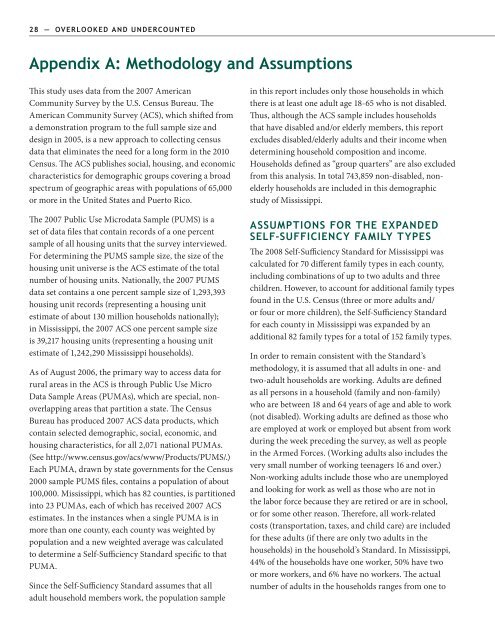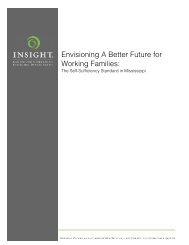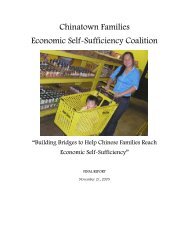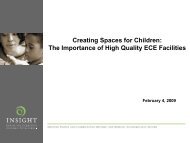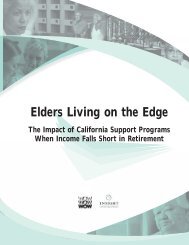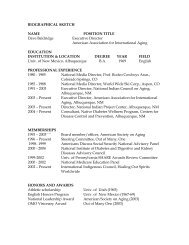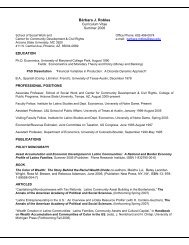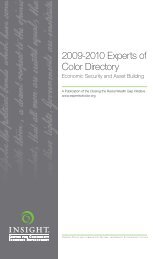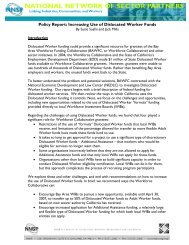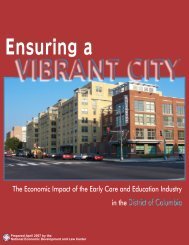Overlooked and Undercounted - Insight Center for Community ...
Overlooked and Undercounted - Insight Center for Community ...
Overlooked and Undercounted - Insight Center for Community ...
You also want an ePaper? Increase the reach of your titles
YUMPU automatically turns print PDFs into web optimized ePapers that Google loves.
28 — OVERLOOKED AND UNDERCOUNTED<br />
Appendix A: Methodology <strong>and</strong> Assumptions<br />
This study uses data from the 2007 American<br />
<strong>Community</strong> Survey by the U.S. Census Bureau. The<br />
American <strong>Community</strong> Survey (ACS), which shifted from<br />
a demonstration program to the full sample size <strong>and</strong><br />
design in 2005, is a new approach to collecting census<br />
data that eliminates the need <strong>for</strong> a long <strong>for</strong>m in the 2010<br />
Census. The ACS publishes social, housing, <strong>and</strong> economic<br />
characteristics <strong>for</strong> demographic groups covering a broad<br />
spectrum of geographic areas with populations of 65,000<br />
or more in the United States <strong>and</strong> Puerto Rico.<br />
The 2007 Public Use Microdata Sample (PUMS) is a<br />
set of data files that contain records of a one percent<br />
sample of all housing units that the survey interviewed.<br />
For determining the PUMS sample size, the size of the<br />
housing unit universe is the ACS estimate of the total<br />
number of housing units. Nationally, the 2007 PUMS<br />
data set contains a one percent sample size of 1,293,393<br />
housing unit records (representing a housing unit<br />
estimate of about 130 million households nationally);<br />
in Mississippi, the 2007 ACS one percent sample size<br />
is 39,217 housing units (representing a housing unit<br />
estimate of 1,242,290 Mississippi households).<br />
As of August 2006, the primary way to access data <strong>for</strong><br />
rural areas in the ACS is through Public Use Micro<br />
Data Sample Areas (PUMAs), which are special, nonoverlapping<br />
areas that partition a state. The Census<br />
Bureau has produced 2007 ACS data products, which<br />
contain selected demographic, social, economic, <strong>and</strong><br />
housing characteristics, <strong>for</strong> all 2,071 national PUMAs.<br />
(See http://www.census.gov/acs/www/Products/PUMS/.)<br />
Each PUMA, drawn by state governments <strong>for</strong> the Census<br />
2000 sample PUMS files, contains a population of about<br />
100,000. Mississippi, which has 82 counties, is partitioned<br />
into 23 PUMAs, each of which has received 2007 ACS<br />
estimates. In the instances when a single PUMA is in<br />
more than one county, each county was weighted by<br />
population <strong>and</strong> a new weighted average was calculated<br />
to determine a Self-Sufficiency St<strong>and</strong>ard specific to that<br />
PUMA.<br />
Since the Self-Sufficiency St<strong>and</strong>ard assumes that all<br />
adult household members work, the population sample<br />
in this report includes only those households in which<br />
there is at least one adult age 18-65 who is not disabled.<br />
Thus, although the ACS sample includes households<br />
that have disabled <strong>and</strong>/or elderly members, this report<br />
excludes disabled/elderly adults <strong>and</strong> their income when<br />
determining household composition <strong>and</strong> income.<br />
Households defined as “group quarters” are also excluded<br />
from this analysis. In total 743,859 non-disabled, nonelderly<br />
households are included in this demographic<br />
study of Mississippi.<br />
ASSUMPTIONS FOR THE EXPANDED<br />
SELF-SUFFICIENCY FAMILY TYPES<br />
The 2008 Self-Sufficiency St<strong>and</strong>ard <strong>for</strong> Mississippi was<br />
calculated <strong>for</strong> 70 different family types in each county,<br />
including combinations of up to two adults <strong>and</strong> three<br />
children. However, to account <strong>for</strong> additional family types<br />
found in the U.S. Census (three or more adults <strong>and</strong>/<br />
or four or more children), the Self-Sufficiency St<strong>and</strong>ard<br />
<strong>for</strong> each county in Mississippi was exp<strong>and</strong>ed by an<br />
additional 82 family types <strong>for</strong> a total of 152 family types.<br />
In order to remain consistent with the St<strong>and</strong>ard’s<br />
methodology, it is assumed that all adults in one- <strong>and</strong><br />
two-adult households are working. Adults are defined<br />
as all persons in a household (family <strong>and</strong> non-family)<br />
who are between 18 <strong>and</strong> 64 years of age <strong>and</strong> able to work<br />
(not disabled). Working adults are defined as those who<br />
are employed at work or employed but absent from work<br />
during the week preceding the survey, as well as people<br />
in the Armed Forces. (Working adults also includes the<br />
very small number of working teenagers 16 <strong>and</strong> over.)<br />
Non-working adults include those who are unemployed<br />
<strong>and</strong> looking <strong>for</strong> work as well as those who are not in<br />
the labor <strong>for</strong>ce because they are retired or are in school,<br />
or <strong>for</strong> some other reason. There<strong>for</strong>e, all work-related<br />
costs (transportation, taxes, <strong>and</strong> child care) are included<br />
<strong>for</strong> these adults (if there are only two adults in the<br />
households) in the household’s St<strong>and</strong>ard. In Mississippi,<br />
44% of the households have one worker, 50% have two<br />
or more workers, <strong>and</strong> 6% have no workers. The actual<br />
number of adults in the households ranges from one to


